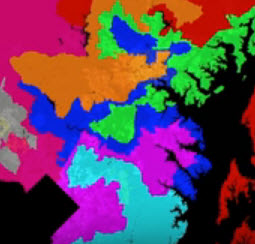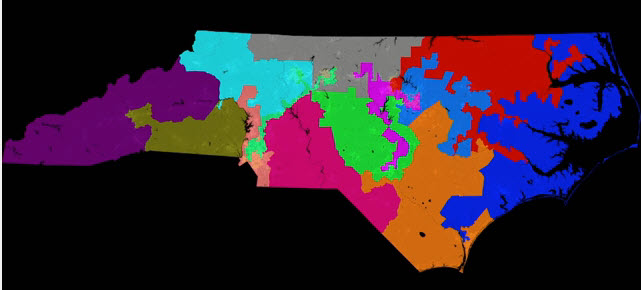Might as Well Call Gerrymandering the 28th Amendment
Dec 1 2021State legislatures around the country are busily using 2020 census data to map voters into newly configured election districts. The grail is to obliterate the opposition party's representation in Congress. There's nothing new about this; it's been going on since the early 1800s. But 
this time, optimized by software advances, gerrymandering will reach extremes not seen before, and the new redistricting will engineer elections for the full decade until the 2030 census. America as a democracy is becoming a myth.
It doesn't have to be this way. We could easily have a pure democracy if it weren't for the political parties' lust for power. We'll explain how below.
hard right rudderRepublicans decidedly hold the upper hand in the gerrymander sweepstakes. The party has trifectas — control of both chambers of the state legislature as well as the governorship — in 23 states, and in addition controls both legislative branches in seven others. Democrats have only 15 trifectas and control both legislative chambers in only three others.
The remaining 12 states have opted for redistricting commissions to draw the maps for congressional elections.
illiberal artMap designers or software algorithms employ the techniques of "cracking" and "packing" to neuter the votes of the opposition party. Cracking is used to split areas where that party predominates, spreading their votes into districts where they will be safely outnumbered and have no effect. Packing often surrenders a district to the opposition, but crams it with as many opposition voters as possible to purge them from surrounding districts so as there to guarantee the opposition will loss. The Republican motive is often to isolate Blacks who vote overwhelmingly Democratic, as when the Alabama legislature packed a district which already had a 72% majority of Blacks with 16,000 more. "Bleached of their reliable Democratic voters, the surrounding districts become safe for Republicans", as a Wall Street Journal op-ed writer put it. Supreme Court Chief Justice John Roberts calls it the “sordid business of divvying us up by race”.
An added effect of gerrymandering is that, while it removes districts from the competition of the opposing party in order to guarantee re-election of incumbents every other November, it shifts incumbents' risk to the primaries. A representative running for re-election is made vulnerable to the threat of a more extreme challenger of his or her party. Woe betide incumbents guilty of any deviance from doctrine while in office. They will be sent packing because it is the most ideologically extreme who come out to vote in the primaries.
crimes against geography
The contorted shapes that gerrymandering produces look like accidents in a supermarket aisle, or like this bug splat, 
Blue marks the controversial 2016
Democratic district, part of which
lies along Chesapeake Bay, in black.
a Maryland district in 2016. Connected by tiny threads and leaping across water, it consists of parts of Baltimore, Annapolis and three counties. There are more map excerpts where that came from if interested: click though to a "Gallery of Gerrymanders" Let's Fix This Country put together that year. By their tortured designs alone, these gargoyles of engineered voting are testament that our elections are seriously wrong, that our democracy needs an asterisk.
Gerrymandering is already producing the expected distortions this year. Democratic Illinois has lost a seat from population decline but is using muscular gerrymandering to make certain it's a Republican seat that's cut plus replacing a second with a Democrat.
Maryland, which had some fame this past decade for a strung-out district, may redraw it so as to eliminate the state's single Republican representative out of its total of eight.
But it's the Republicans who will come up with far more gerrymandered districts — because they can (see above).
Trump won 52% of Texans' votes but governor Greg Abbott has signed into law a map that's gerrymandered to award 66% of congressional seats to Republicans.
Ohio went 53-to-45 for Trump but its proposed map gives Democrats only two congressional seats out of its allotment of 15.
North Carolina is a serial violator of gerrymander excess. It was forced by the courts to redraw its maps twice since 2011. Whereas Donald Trump had won the 2016 election by under 4% in that purple state, its gerrymandered maps had given Republicans 10 of 13 seats. The court-approved redrawing made that 8 of 13 in the 2020 election, but now the Tarheel legislature is at it again. Republicans have come up with a map to make it the same 10 Republican and 3 Democratic districts, plus one competitive to make 14 (the census added one representative) despite Trump edging Biden by only 1.3%.
We will see many more examples in the coming months as states complete their grotesquery of this form of voter suppression where citizens are cloistered away to where their votes will have no effect.
Which is not to say that the commissions adopted by the dozen states are providing a Utopian solution. Squabbles in Virginia erupted in shouting matches, no resolution, and the commission members gave up. In Ohio the Republican-controlled legislature overrode the redistricting commission and drew its own map. In New York, which lost a seat owing to population shrinkage, Democrats want to collapse an upstate Republican district that suffered that fate, but Republicans would rather merge two Democratic districts up river from New York City, forcing one Democrat to eliminate the other. No agreement there.
moot courtCourt fights will ensue in every election year of the coming decade, but one court that is unlikely to be involved is the high court in Washington, D.C. In 2019, the Supreme Court dealt with a couple of cases and decided that, while they would step in when gerrymandering appears to be racially motivated in violation of what's left of the 1965 Voting Rights Act– cracking or packing Black districts, say — they would no longer take on cases of partisan political battles, no matter the threat to democracy of leaving state legislatures free to eviscerate the opposition party.
The Court has as an excuse Article I, Section 4, of the Constitution which gives control of "The Times, Places and Manner of holding Elections for Senators and Representatives" to the state legislatures, but Congress has none. That same sentence goes on to say, "but the Congress may at any time by Law make or alter such Regulations." Pamela Karlan, a professor at Stanford Law School, says, "Congress could pass a law tomorrow to move to a system of proportional representation". That would rid the country of the whole disreputable practice of self-interested politicians drawing maps with sole purpose to keep themselves in office.
Democrats are for itIntroduced in the Senate in September, the Freedom to Vote Act would ban gerrymandering as one of its provisions, establishing rules, increased transparency, and ensuring that gerrymandered or discriminatory maps can quickly be challenged in court. The bill requires 60 votes in the Senate, though, unless Democrats vote to kill the filibuster so as to pass the bill with a simple majority. Every last senator plus tie-breaker Kamala Harris is needed to end the filibuster and then pass the bill, but then there are two senators, Joe Manchin of West Virginia and and Arizona's Kyrsten Sinema, who have expresses their opposition. Republicans, led by Mitch McConnell, are dead against the legislation. So the bill's prospects are dim.
That leads us to the solution we referred to at the outset.
the fixThe law requires each congressional district to have approximately the same population. Population densities vary across a map, rivers and lakes intrude, highways bisect, so dividing a state into the number of districts that matches the number of congressional representatives that its population allows, with each district having the same number of people, is more than a doodle on a napkin.
Sadly, software companies have obligingly taken redistricting to extremes by creating the tools to assist states in gerrymandering the opposition party virtually out of existence. More's the pity that the same software logic could be repurposed to rid us of gerrymandering for good.
Handed census data, software code would begin by dividing a state into the nearest to equal size rectangles that irregular borders permit. Algorithms then recursively adjust each area's shape and size — with zero regard to political parties and ethnic groups — until optimally equal populations occupy each district.
Job done. The wasteful and contentious lawsuits and court cases would vanish.
And it's not that difficult. Appalled by the corruption of gerrymandering, a Massachusetts software engineer named Brian Olson pulled it off as we reported years ago. He created software — open source that you could even run on your home computer — that could apply the same uniform algorithms to the census maps of all 50 states. He went on to make this something of a crusade, replete with TED talk.
We'll keep North Carolina in the spotlight. Here is the original offending map at the time Olson developed his application. Following it is the simplified result that emerges from his application's neutral rendering:


But no attention is ever paid. Justices of the Supreme Court have lamented no one has come up with a standard by which overly partisan gerrymandering could be struck down. And yet there is a standard in Article IV, Section 4, which the Court has three times chosen to pass off to Congress despite its saying "The United States shall guarantee to every State in this Union a Republican Form of Government". The United States, not Congress. If states become so corrupted that the votes of subsets of their citizenry are repressed so as to have no count, Justice John Marshall Harlan wrote of the courts' responsibility in his dissent in 1896's Plessy v. Ferguson.
"Such a system is inconsistent with the guarantee given by the Constitution to each State of a republican form of government, and may be stricken down by congressional action, or by the courts in the discharge of their solemn duty to maintain the supreme law of the land".
This being a passion of ours, in 2019 we sent this letter individually addressed to each of the nine justices in the hopes of awakening them to this wholly agnostic software solution. It did no good, of course. Not one of them (they each have staffs, don't they?) had the courtesy to reply with a form letter, an e-mail acknowledgement, a postcard — zero.
Please subscribe if you haven't, or post a comment below about this article, or
click here to go to our front page.


Interesting article which updated my understanding of gerrymandering and revealed the hypocrisy or failure of SCOTUS to provide any remedy. Combined with current attempts at voter suppression, the constitutional provisions for membership in the Senate and the electoral college, we are a long way from a democracy. Given the holdout of two Democrat Senators, I do not have much hope for passing federal voting regulations.